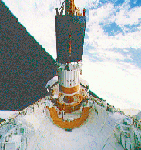|
|
The Diffuse X-ray Spectrometer

The Diffuse X-Ray Spectrometer (DXS) consisted of 2 large area Bragg
crystal spectrometers that covered the energy range 0.15 - 0.28 keV.
DXS was flown as an attached payload of the Space Shuttle (STS-54) and
the two spectrometers were mounted on opposite sides of the shuttle cargo
bay as part of the GSFC Shuttle Payload of Opportunity Carrier system,
part of the Hitchhiker shuttle series.
The experiment was designed primarily to detect the diffuse X-ray
background. During the 80 orbit nights of DXS data collection time
during the shuttle mission, the orbiter was oriented such that the DXS
detectors repeatedly scanned the same arc on the sky - within 10° of
the galactic plane from longitudes 150°-300°. The sky covered
was divided into 5 distinct regions Auriga, MonoGemPuppis Vela and Crux.
DXS consisted of 2 large area Bragg crystal spectrometers. Each DXS
detector contained a curved panel of Bragg crystals mounted above a
position-sensitive proportional counter. A spectrum would be dispersed
across the counter, with all portions of the spectrum being measured
simultaneously. This eliminated the problem in conventional Bragg
spectrometers of false features being introduced by a time-varying
background. Yet while all wavelengths were measured at the same time,
the various wavelengths came from different directions in the sky. Thus,
the spectrometers were rocked back and forth about an axis perpendicular
to the dispersed direction to obtain complete spectral coverage along an
arc of the sky.
[DXS Home]
[About DXS]
[Archive]
[Gallery]
[Publications]
Page authors: Lorella Angelini Jesse Allen
HEASARC Home |
Observatories |
Archive |
Calibration |
Software |
Tools |
Students/Teachers/Public
Last modified: Monday, 20-Apr-2020 18:12:26 EDT
|


